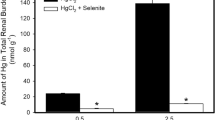Abstract
Forty-eight hours after the simultaneous administration of either 1.8 μmoles Se (as Na2SeO3) to 200 g male rats with equivalent doses of Cd (as CdCl2) or 0.5 μmoles Se with equivalent doses of Hg (as HgCl2) the retention of selenium at the subcutaneous injection site was affected only when it was given in a single injection with the heavy metal. The retention of cadmium was increased only if selenium was injected separately and the retention of mercury was increased both in single and separate injections. When there was an increase in retention at the site of injection, this made up less than 8% of the dose for selenium and mercury and 3% for cadmium and thus could not explain either changes in distribution or the reported protective effects by one metal against the other. The shift in the distribution pattern of one metal caused by the other metal was similar, and independent of whether they were injected in single or separate injections. However the shift in the distribution of interacting metals showed some differences indicating that interaction could not be mediated through the formation of a stable complex between selenium on the one hand and mercury or cadmium on the other.
Zusammenfassung
200 g schwere männliche Ratten erhielten gleichzeitig entweder 1,8 μmol Selen (als Na2SeO3) und eine equivalente Dosis Kadmium (als CdCl2) oder 0,5 μmol Selen und eine equivalente Dosis Quecksilber (als HgCl2). Die Retention des Selens an der Stelle der subcutanen Injektion 48 Std nach der Applikation wurde nur dann beeinflußt, wenn dieses in einer einzigen Injektion mit dem Schwermetall gegeben wurde. Die Retention des Kadmiums nahm nur zu, wenn das Selen getrennt injiziert wurde, und die Retention des Quecksilbers war sowohl bei gemeinsamer als auch bei getrennter Injektion erhöht. Wenn eine Zunahme der Retention an der Injektionsstelle gefunden wurde, so machte diese weniger als 8% der Dosis für Selen ud Quecksilber und 3% für Kadmium aus. Dieses reicht nicht aus, um entweder die Unterschiede in der Verteilung oder den protektiven Effekt, den die Metalle untereinander ausüben sollen, zu erklären. Die Veränderung des Verteilungsmusters eines Metalls, verursacht durch ein anderes Metall, war ähnlich und unabhängig davon, ob sie in einer einzigen oder in getrennten Injektionen gegeben wurden. Allerdings zeigt die Änderung der Verteilung von Metallen, die in Wechselwirkung treten, einige Unterschiede, die darauf hinweisen, daß dieser Effekt nicht auf der Bildung eines stabilen Komplexes zwischen Selen auf der einen Seite und Quecksilber und Kadmium auf der anderen beruht.
Similar content being viewed by others

References
Eybl, V., Sykora, J., Mertl, F.: Einfluß von Natriumselenit, Natriumtellurit und Natriumsulfit auf Retention und Verteilung von Quecksilber bei Mäusen. Arch. Toxikol. 25, 296–305 (1969)
Gasiewicz, T. A., Smith, J. C.: Interactions of cadmium and selenium in rat plasma in vivo and in vitro. Biochim. biophys. Acta (Amst.) 428, 113–122 (1976)
Gunn, S. A., Gould, T. C., Anderson, W. A. D.: Selectivity of organ response to cadmium injury and various protective measures. J. Path. Bact. 96, 89–96 (1968)
Hill, C. H.: Reversal of selenium toxicity in chicks by mercury, copper and cadmium. J. Nutr. 104, 593–598 (1974)
Hill, C. H.: Inter-relationships of selenium with other trace elements. Fed. Proc. 34, 2096–2100 (1975)
Kar, A. B., Das, R. R. P., Mukerji, B.: Prevention of cadmium induced changes in the gonads of rat by zinc and selenium — a study in antagonism between metals in the biological systm. Proc. Nat. Inst. Sci. India 26 (Suppl), 40 (1960)
McConnel, K. P., Carpenter, D. M.: Inter-relationship between selenium and specific trace elements. Proc. Soc. exp. Biol. (N.Y.) 137, 996–1001 (1971)
Moffitt, A. E. Jr., Clary, J. J.: Selenite-induced binding of inorganic mercury in blood and other tissues in the rat. Res. Comm. Chem. Path. Pharmacol. 7, 593–603 (1974)
Painter, E. P.: The chemistry and toxicity of selenium compounds with special reference to the selenium problem. Chem. Rev. 28, 197–213 (1941)
Parizek, J.: The detoxifying effects of selenium: inter-relations between compounds of selenium and certain metals. In: Newer trace elements in nutrition (W. Meltz, W. E. Cornatzer, Eds.), pp. 85–122. New York: Dekker 1971
Sandholm, M.: Selenium carrier proteins is mouse plasma. Acta Pharmacol. Toxicol. 35, 424–428 (1974)
Sandholm, M.: Function of erythrocytes in attaching selenite-Se onto specific plasma proteins. Acta Pharmacol. Toxicol. 36, 321–327 (1975)
Author information
Authors and Affiliations
Additional information
Supported partly by International Atomic Energy Agency, Grant Number 1530/RB
Rights and permissions
About this article
Cite this article
Magos, L., Webb, M. Differences in distribution and excretion of selenium and cadmium or mercury after their simultaneous administration subcutaneously in equimolar doses. Arch. Toxicol. 36, 63–69 (1976). https://doi.org/10.1007/BF00277564
Received:
Issue Date:
DOI: https://doi.org/10.1007/BF00277564



